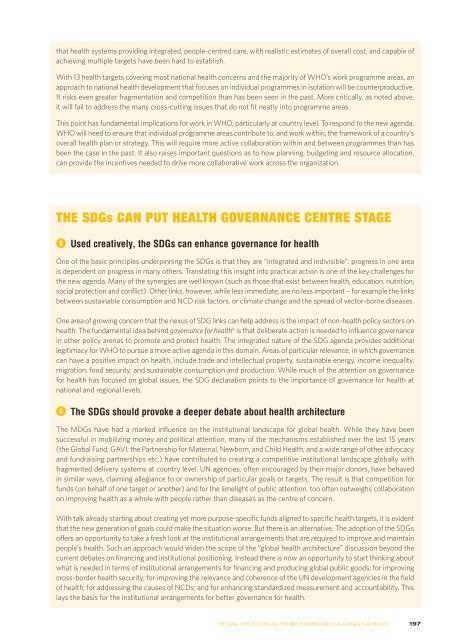Create successful ePaper yourself
Turn your PDF publications into a flip-book with our unique Google optimized e-Paper software.
that health systems providing integrated, people-centred care, with realistic estimates of overall cost, and capable of<br />
achieving multiple targets have been hard <strong>to</strong> establish.<br />
With 13 health targets covering most national health concerns and the majority of WHO’s work programme areas, an<br />
approach <strong>to</strong> national health development that focuses on individual programmes in isolation will be counterproductive.<br />
It risks even greater fragmentation and competition than has been seen in the past. More critically, as noted above,<br />
it will fail <strong>to</strong> address the many cross-cutting issues that do not fit neatly in<strong>to</strong> programme areas.<br />
This point has fundamental implications for work in WHO, particularly at country level. To respond <strong>to</strong> the new agenda,<br />
WHO will need <strong>to</strong> ensure that individual programme areas contribute <strong>to</strong>, and work within, the framework of a country’s<br />
overall health plan or strategy. This will require more active collaboration within and between programmes than has<br />
been the case in the past. It also raises important questions as <strong>to</strong> how planning, budgeting and resource allocation,<br />
can provide the incentives needed <strong>to</strong> drive more collaborative work across the organization.<br />
THE SDGs CAN PUT HEALTH GOVERNANCE CENTRE STAGE<br />
5 Used creatively, the SDGs can enhance governance for health<br />
One of the basic principles underpinning the SDGs is that they are “integrated and indivisible”: progress in one area<br />
is dependent on progress in many others. Translating this insight in<strong>to</strong> practical action is one of the key challenges for<br />
the new agenda. Many of the synergies are well known (such as those that exist between health, education, nutrition,<br />
social protection and conflict). Other links, however, while less immediate, are no less important – for example the links<br />
between sustainable consumption and NCD risk fac<strong>to</strong>rs, or climate change and the spread of vec<strong>to</strong>r-borne diseases.<br />
One area of growing concern that the nexus of SDG links can help address is the impact of non-health policy sec<strong>to</strong>rs on<br />
health. The fundamental idea behind governance for health 6 is that deliberate action is needed <strong>to</strong> influence governance<br />
in other policy arenas <strong>to</strong> promote and protect health. The integrated nature of the SDG agenda provides additional<br />
legitimacy for WHO <strong>to</strong> pursue a more active agenda in this domain. Areas of particular relevance, in which governance<br />
can have a positive impact on health, include trade and intellectual property, sustainable energy, income inequality,<br />
migration, food security, and sustainable consumption and production. While much of the attention on governance<br />
for health has focused on global issues, the SDG declaration points <strong>to</strong> the importance of governance for health at<br />
national and regional levels.<br />
6 The SDGs should provoke a deeper debate about health architecture<br />
The MDGs have had a marked influence on the institutional landscape for global health. While they have been<br />
successful in mobilizing money and political attention, many of the mechanisms established over the last 15 years<br />
(the Global Fund; GAVI; the Partnership for Maternal, Newborn, and Child Health; and a wide range of other advocacy<br />
and fundraising partnerships etc.) have contributed <strong>to</strong> creating a competitive institutional landscape globally with<br />
fragmented delivery systems at country level. UN agencies, often encouraged by their major donors, have behaved<br />
in similar ways, claiming allegiance <strong>to</strong> or ownership of particular goals or targets. The result is that competition for<br />
funds (on behalf of one target or another) and for the limelight of public attention, <strong>to</strong>o often outweighs collaboration<br />
on improving health as a whole with people rather than diseases as the centre of concern.<br />
With talk already starting about creating yet more purpose-specific funds aligned <strong>to</strong> specific health targets, it is evident<br />
that the new generation of goals could make the situation worse. But there is an alternative. The adoption of the SDGs<br />
offers an opportunity <strong>to</strong> take a fresh look at the institutional arrangements that are required <strong>to</strong> improve and maintain<br />
people’s health. Such an approach would widen the scope of the “global health architecture” discussion beyond the<br />
current debates on financing and institutional positioning. Instead there is now an opportunity <strong>to</strong> start thinking about<br />
what is needed in terms of institutional arrangements for financing and producing global public goods; for improving<br />
cross-border health security; for improving the relevance and coherence of the UN development agencies in the field<br />
of health; for addressing the causes of NCDs; and for enhancing standardized measurement and accountability. This<br />
lays the basis for the institutional arrangements for better governance for health.<br />
THE SDGs: REFLECTIONS ON THE IMPLICATIONS AND CHALLENGES FOR HEALTH<br />
197


